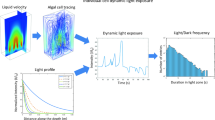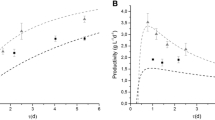Abstract
For mass production of microalgae outdoors to be justified as a significant commercial entity, solar energy should be utilized at a much higher efficiency, yielding greatly increased photosynthetic productivity than presently obtained. Development of photobioreactors to provide an answer for this challenge rests at the root and the very future of this biotechnology. Most available Photobioreactors yield increased volumetric outputs of cell mass, but the areal yield which relates to the photosynthetic efficiency is rather similar to that obtained in the basically inefficient open raceway, the most prevalent commercial reactor today. The key for efficient utilization of the super saturating solar irradiance existing outdoors rests in distributing it, in effect, to as large a number of cells per given volume in as high a frequency as possible. This unfolds the design principles underlying efficient utilization of high irradiance for photoautotrophic production of cell mass: Reactors should be maximally exposed to sun light, have a narrow light-path coupled with a safe mixing system designed to create fast, turbulent streaming for moving the algal cells in and out of the photic volume at maximal frequency. Reactors designed along these principles may support ultrahigh cell densities resulting in high volumetric as well as areal yields, hopefully expanding thereby the economic basis of microalgal biotechnology.
Similar content being viewed by others
References
Cohen E (Malis), Arad S. (1989) A closed system for outdoor cultivation ofPorphyridium. Biomass 18: 59–67.
Edmund T, Lee Y, Bazin MJ (1990) A laboratory scale air-lift helical photobioreactor to increase biomass output rate of photosynthetic algal cultures. New Phytol. 116: 331–335.
Gittelson A, Hu Q, Richmond A (1996) The photic volume in photobioreactors supporting super-high population densities of the photoautotrophSpirulina platensis. J. appl. Environ. Microbiol. 62: 1570–1573.
Goldman JC (1979) Outdoor algal mass cultures II. Photosynthetic yield limitations. Wat. Res. 13: 119–136.
Grobbelaar JU (1994) Turbulence in mass algal cultures and the role of light/dark fluctuations. J. appl. Phycol. 6: 331–335.
Gudin C, Chaumont D (1983) Solar biotechnology study and development of tubular solar receptors. In Palz W, Pirruitz D (eds), Energy from Biomass Series E. Volume 5, D. Reidel Dordrecht: 184–193.
Hu Q (1997) Qualitative assessment of factors limiting growth and productivity in continuous outdoor cultures of microalgal. Ph. D. dissertation. Ben-Gurion Univ. Israel.
Hu Q, Richmond A (1994) Optimizing the population density inIsochrysis galbana grown outdoors in a glass column photobioreactor. J. appl. Phycol. 6: 391–396.
Hu Q, Richmond A (1996) Productivity and photosynthetic efficiency ofSpirulina platensis as affected by light intensity, cell density and rate of mixing in a flat plate photobioreactor. J. appl. Phycol. (in press).
Hu Q, Guterman H, Richmond A (1996a) A flat inclined modular photobiorector (FIMP) for outdoor mass cultivation of photoautotrophs. Biotechnol. Bioengng. 51: 51–60.
Hu Q, Guterman H, Richmond A (1996b) Physiological characteristics ofSpirulina platensis (Cyanobacteria) cultured at ultrahigh cell densities. J. Phycol. (In press).
Javanmardian M., Palsson B (1991) High-density photoautotrophic algal cultures: design, construction, and operation of a novel photobioreactor system. Biotechnol. Bioengng. 38: 1182–1189.
Kok B. (1953) In Burlew JS (ed.) Algal culture: from laboratory to pilot plant. Carnegie Institute. Washington. Pub. 600: 63–75.
Lee YK, Low CS (1991) Effect of photobioreactor inclination on the biomass production of an outdoor algal culture. Biotechnol. Bioengng. 38: 995–1000.
Lee CG, Palsson BØ (1994) High-density algal photobioreactors using light emitting diodes. Biotechnol. Bioengng. 40: 1161–1167.
Pirt SJ, Lee YK, Walach MR, Pirt MW, Balyuzi, HHM, Bazin MJ (1983) A tubular bioreactor for photosynthetic production of biomass from carbon dioxide: design and performance. J. Chem. Tech. Biotechnol. 33: 35–58.
Pulz O (1994) Open-air and semi-closed cultivation systems for the mass cultivation of microalgae. In Phang SM, Lee YK, Borowitzka MA, Whitton BA (eds), Algal Biotechnology in the Asia-Pacific Region. University of Malaya: 113–117.
Richmond A, Boussiba S, Vonshak A, Kopel R (1993) A new tubular reactor for mass production of microalgae outdoors. J. appl. Phycol. 5: 327–332.
Terry KL (1986) Photosynthesis in modulated light: quantitative dependence of photosynthetic enhancement on flashing rate. Biotechnol. Bioengng 28: 988–995.
Torzillo G, Pushparaj B, Bocci F, Balloni W, Materassi R, Florenzano G (1986) Production ofSpirulina biomass in closed photobioreactors. Biomass 11: 61–74.
Tredici MR, Carlozzi P, Zittelli GC, Materassi R (1991) A vertical alveolar panel (VAP) for outdoor mass cultivation of microalgae and cyanobacteria. Bioresource Technology 38: 153–159.
Tredici MR, Materassi R (1992) From open ponds to vertical alveolar panels: The Italian experience in the development of reactor for the mass cultivation of photoautotrophic microorganisms. J. appl. Phycol. 4: 221–231.
Author information
Authors and Affiliations
Rights and permissions
About this article
Cite this article
Richmond, A. Efficient utilization of high irradiance for production of photoautotropic cell mass: a survey. J Appl Phycol 8, 381–387 (1996). https://doi.org/10.1007/BF02178581
Received:
Revised:
Accepted:
Issue Date:
DOI: https://doi.org/10.1007/BF02178581




